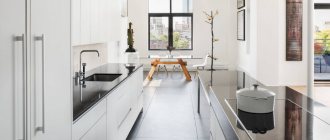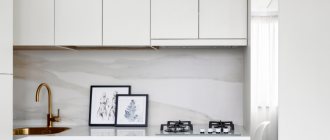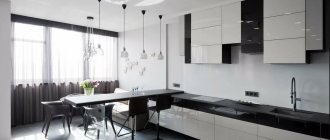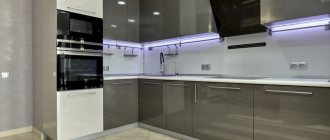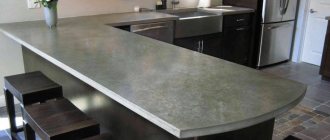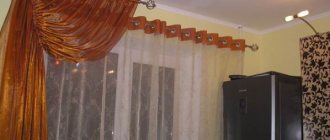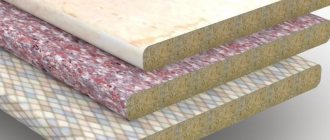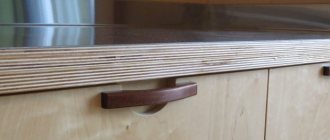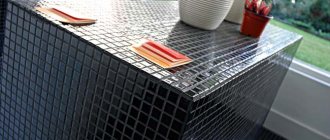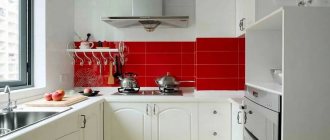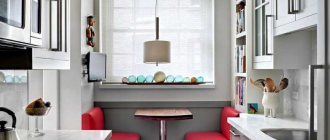Which countertop to choose for a white kitchen? The final decision is influenced by many factors: the color of the apron, floor, dining table. White is a color that attracts attention under any circumstances! Kitchens in this color are airy and fashionable. The interior in this color looks expensive.
They can decorate literally everything: windows, walls, furniture, curtains, tables and chairs. It is important not to overdo it, otherwise the interior will become boring and look like a hospital ward.
A tabletop with a wood texture perfectly dilutes the dominant white shade.
It is better to dilute the whiteness with some other colors - bright accents. These could be furniture elements, textiles or dishes.
How to do this harmoniously? We'll tell you here.
ABOUT WHITE COLOR IN INTERIORS
White visually enlarges the room - it expands the walls, raises the ceilings. Kitchens in this color are on trend today.
It always remains, as it were, “above” fashion, because it is universal and appropriate everywhere - both in modern and classic interiors. White will be indispensable if the room lacks natural light.
White color can be combined with any shades, has a calming effect on the psyche, and also masks minor imperfections in the interior.
Dark shades of classics
The stone surface is cold and attractive. This is what a tabletop looks like in a classic style. Highlighting the whiteness of kitchen cabinets and adding weight to the atmosphere is just a small part of what it can do.
But the stone owes its popularity to its properties:
- durable and scratch resistant;
- perfectly polished;
- wine or coffee will not leave any stains on it, thanks to its dense structure.
Dark brown color is another companion to the classic white kitchen. It can be adopted by those who are alien to stone coldness and inaccessibility.
WHICH WORKTOPS TO CHOOSE FOR A WHITE KITCHEN
We will try to give you the most detailed answer to the question of which countertop to choose for a white kitchen.
Details - it would seem a trifle, but first of all you need to pay attention to them. Remember to think of the space as a whole. The surface of the set must be selected so that there is no imbalance in the overall atmosphere, while it remains the main kitchen element.
The countertop needs to look harmonious in the kitchen. Make sure that its color matches at least one item - the dining table, apron, window sill, facade, flooring, curtains. Let's consider the options in more detail.
WE SELECT FOR FACADES
You can order facades made of the same material. For example, if the facade is wooden and painted white, then the work surface should also be made like this.
White countertop under white facades. Style – high-tech.
Also pay attention to the finishing coat. Glossy or matte? If the second option, then a bright surface will help balance such a façade.
But it is better to soften glossy facades with a work surface with a minimalist design.
If you decide to make the facade and tabletop in the same color, create contrast in another place - in the dining area. Or use bright textiles.
UNDER THE APRON
Creating such a combination is the simplest solution.
Firstly, an apron in a white kitchen will take all the attention. And if you make the work surface in the same tone as the apron, you won’t have to rack your brains to create color combinations.
Secondly, the apron and countertop can simply be made from the same material. For example, lay out the surface of the work area with tiles, and create marble slabs instead of an apron.
Wooden beauty of Scandinavia
The Scandinavian style has absorbed all the harshness of the climate of those regions: natural materials in light, cold shades and the presence of simple geometric shapes. A tabletop made of solid wood can soften the interior and give it a little warmth. This material is distinguished by its original structure and environmental friendliness - the dream of many housewives.
Preference should be given to light wooden shades, since dark ones create the impression of pressure on the fragile white walls of the cabinets.
If the structure of wood is not to your liking, but Scandinavia is your passion, a light brown countertop option made of chipboard or MDF will help fulfill your desire. The price will be even cheaper.
WHAT COLOR OF COUNTERTOP TO CHOOSE FOR A WHITE KITCHEN?
AND THERE IS WHITE AROUND
And we’re not talking about a snowy winter landscape, but about a white work surface in a white kitchen.
This choice can be called universal, because the design will be monochrome. The working surface can be made of different materials - laminate, stone, chipboard, chipboard.
Is this practical? Most often they say that a light-colored work surface is very inconvenient. But experience shows otherwise - dust, small scratches, water stains and other imperfections will be invisible to the eye.
WHITE KITCHEN DESIGN WITH BLACK COUNTERTOPS
A white kitchen with a black countertop in the interior – a barrel of honey with a fly in the ointment? No!
Black countertops go well with white and wood textures.
This is a classic combination, which means it is always relevant. The issue of practicality is more acute here than in the previous version. A white kitchen with a black countertop – it looks stylish in the interior photo.
It is on a dark surface that stains and dirt will be most noticeable, no matter how paradoxical it may sound. Therefore, you will have to look after her more often than others.
WHITE KITCHEN WITH BROWN COUNTERTOPS IN THE INTERIOR
The design of a white kitchen with a brown countertop is most often an option with a wooden work surface.
Light brown shade with a laminated wood texture.
By the way, lighting plays a role. The same kitchen from a different angle looks different. Experiment with light to get the best results.
Shades can be different - from light (beige) to dark (wenge) or red. A wooden countertop in a white kitchen is environmentally friendly, but quite expensive.
And it doesn’t matter that white and brown are opposites. They look very cool in a duet. This surface shade makes the set more noble.
A white kitchen with a brown countertop will look best in interiors in loft, modern and classic styles.
WHITE KITCHEN DESIGN WITH GRAY COUNTERTOPS
A white kitchen with a gray countertop in the interior is beautiful. After all, gray perfectly sets off the whiteness of the space in general and the headset in particular.
Dark shades of gray go well with white facades.
Such a work surface will not attract undue attention to itself. When it comes to gray, most often it is a white kitchen with a marble countertop - they look perfect in the interior!
Surfaces made of artificial stone are also often in a gray shade. It evokes the best associations with natural rock.
INDIGO IS UNUSUAL! ABOUT BLUE WORK SURFACES
Most often, the most unusual solutions can be seen in fashionable designs. The combination of a white kitchen with a blue countertop can be considered such a bold one!
Blue shades go well with white and metallic elements.
Suitable for modern, high-tech and marine-themed interiors.
If you make the tabletop dark blue, it will become a cool decoration for a Scandinavian interior. In the classics you can also find blue countertops, but here they should be lighter - blue or light blue.
RED
Red and white are a classic duo, but quite a bold solution for the kitchen. After all, white will only emphasize the brightness and boldness of red, so this combination is best suited for kitchens in the high-tech or minimalist style.
Red is a rather rare option. However, some people like it.
Pink
Pink, unlike red or green, has a large number of noble shades, which makes it easier to combine with other colors. The combination of pink and gray is widespread and will perfectly complement each other in the kitchen.
In addition, delicate pink will create a wonderful combination with creamy beige - however, such a kitchen is more suitable for girls. It is popular to use pink marble countertops, which will be a good companion for a set of beige-brown shades.
ABOUT WHITE KITCHENS IN DIFFERENT STYLES
White is universal, so it can be seen in both Classic and modern designs. Let's look at how it will be used in different styles:
| Style | Using color in elements |
| Romanticism | Pearl shade of white, decorative elements, handles. |
| Baroque | Tables and shelves with silver or gilded details, order elements, and other Renaissance decor. |
| Rococo | Stylized shells. |
| Classical | Milky shade, moldings on furniture, carved elements, glass inserts on hanging elements of the set. |
| Neoclassicism | Solid furniture with no expensive or complex elements. |
| Provence | Furniture, doors with wooden frames, craquelure as decoration. |
| Modern | Headsets, lamps, asymmetrical and smooth lines. |
| High tech | Facades , furniture with metal elements. |
| Minimalism | Laconic accessories. |
| Eco style | White with splashes of light beige/light green; |
| Country | Walls, lamps, curtains. |
Yellow
The yellow tabletop is one of the most demanding ones, which are not so easy to combine successfully. The most common variations are yellow-white and yellow-black, and the rules here are much the same as those mentioned when considering red.
If you want your kitchen to be a bright spot, you can dare to combine yellow with red, green or blue, but be very careful in choosing shades.
Many designers believe that light yellow shades are ideal not for countertops, but for wallpaper in the kitchen: it is known that yellow is the best for promoting appetite, so it is indispensable for the kitchen.
Having considered the various design options for the tabletop, let’s summarize: light (white, beige, gray) and dark (brown, black) shades are best suited for this role.
But bright pink, red, yellow and green require great caution: incorrectly selected shades can negate any, even the most interesting, designer’s idea.
Features of the arrangement
The kitchen is considered a work room. Therefore, we cannot do without ergonomics. Tables and cabinets should be comfortable, roomy, located at a convenient height, and accommodate the necessary furniture and equipment.
Standard. Work furniture is installed along one wall. For convenience, it is necessary to separate the sink, oven or hob with a work surface. In this case, it is more convenient to cook and put away clean dishes. The kitchen is conventionally divided into working and dining areas.
Work furniture is installed along one wall
Corner. The white color and L-shaped installation visually change the idea of the shape of the room. Makes long ones cozy. Allows you to use a wall with a window.
Ostrovnaya. The use of island structures is not due to fashion, but to convenience. This element includes a hob, sink and helps define the boundary of the kitchen for apartments and houses with an open plan. Guarantees free movement and facilitates kitchen work.
U-shaped. Suitable for rooms with bay windows, elongated rooms and those combined with a balcony or loggia.
The island is a very fashionable and practical element
Any type of arrangement does not overload the room. The set seems to dissolve and is an addition, not a basic accent. This is what is needed for additional space.
It is necessary to provide space for a dining group. The size of the table depends on family preferences and habits.
The table in the kitchen, the place where the whole family gathers for a meal, is selected according to your preferences
How to care for your kitchen set
Each material has its own care rules. But we can identify a number of general requirements for caring for a kitchen set.
Proper care of your countertop will increase its service life.
- Rule #1. Proper care begins with proper installation. It is not recommended to place radiators nearby.
- Rule #2. Direct sunlight causes the color of furniture to fade quickly. This is especially true for wood.
- Rule #3. For cleaning, only soft products without abrasive particles are used. It is better to use rags made of flannel, cloth or microfiber.
- Rule #4. The use of hard, iron brushes is not recommended, especially for glossy surfaces.
The most popular and controversial color is white for the work surface.
After a detailed description of the general rules on how to choose the color of the countertop and apron in the kitchen, anyone can cope with this task. This does not require any special training or knowledge. It is enough just to take into account some recommendations.
